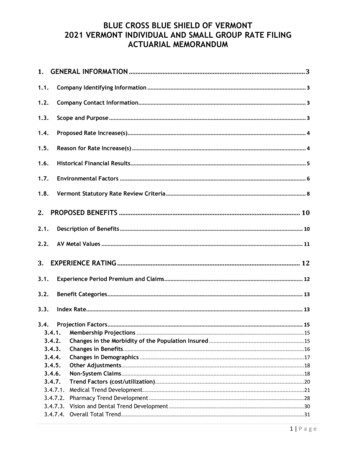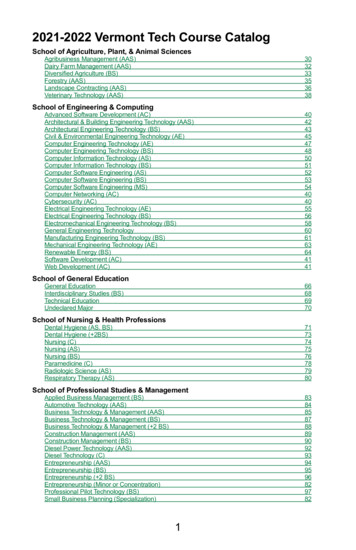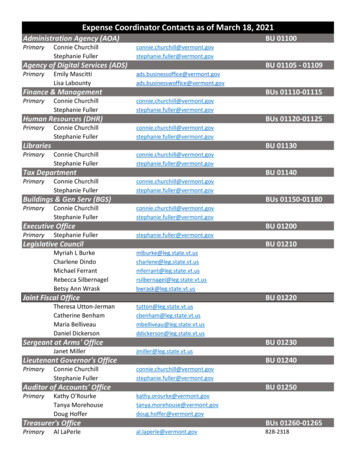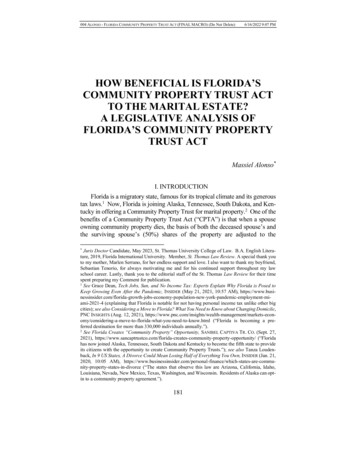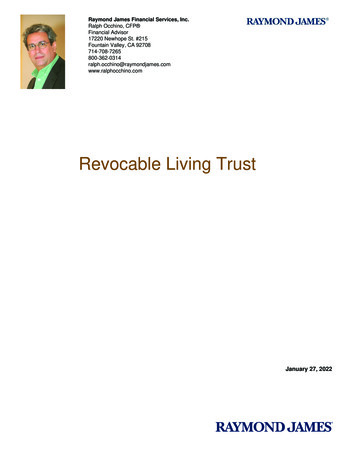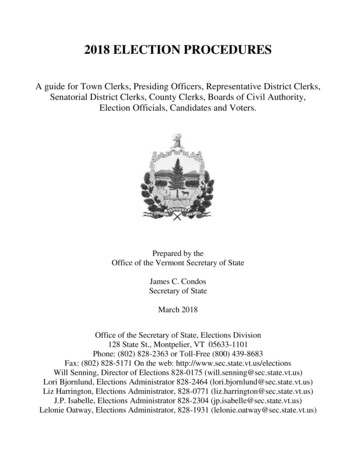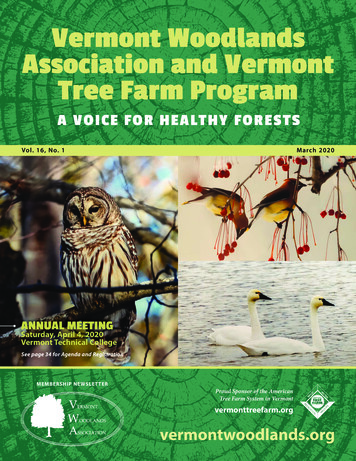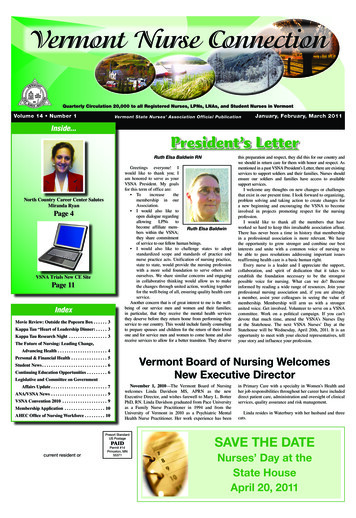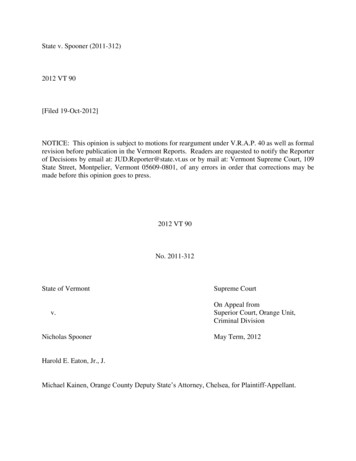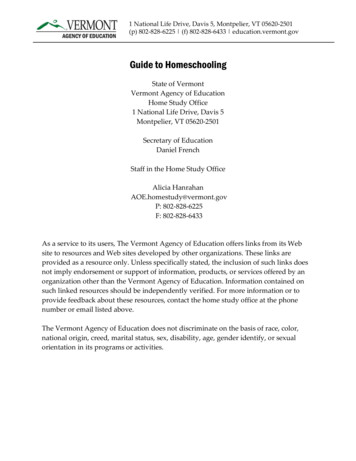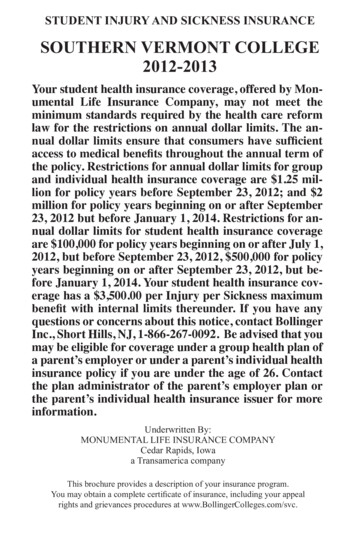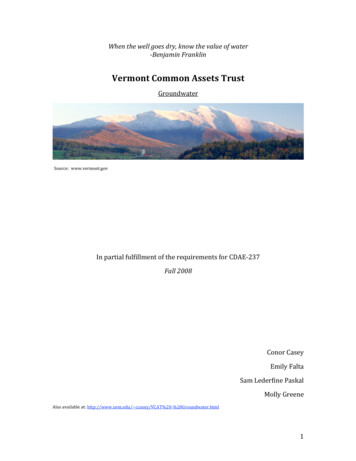
Transcription
When the well goes dry, know the value of water Benjamin FranklinVermont Common Assets TrustGroundwaterSource: www.vermont.govIn partial fulfillment of the requirements for CDAE‐237Fall 2008Conor CaseyEmily FaltaSam Lederfine PaskalMolly GreeneAlso available at: http://www.uvm.edu/ ccasey/VCAT%20‐%20Groundwater.html1
Table of rence Analysis9Delphi Results11Current Conclusion19References20Appendix A: Delphi Survey Round 122Appendix B: Project Contacts23Appendix C: Survey Cover Letter26Appendix D: Links to Groundwater Maps27Appendix E: Groundwater Mapping28Appendix F: Literature Review29Lit Review Works Cited382
Introduction:Water is a rival, non‐excludable resource that is essential to all life on earth.Two‐thirds of Vermonters depend on groundwater for drinking and other necessarywater uses, (VNRC, 2007). In addition to domestic use, other sectors, such asagriculture and industry rely on groundwater, as does the production of consumergoods that incorporate water into the finished product (i.e. bottled water). Anothertremendously important function of groundwater in Vermont is the way in which itinteracts with surface water in recharging surface water stocks (lakes, ponds) andflows (streams, rivers) that aquatic ecosystems rely on.Conventional markets fail to appropriately manage this ecosystem good aswell as the services it provides. Markets fail to take sustainable scale intoconsideration and often contribute to an inequitable distribution of wealth. Withoutproper institutions to regulate and monitor use of groundwater, corporations andheavy users benefit from managing the resource irresponsibly, making short‐termprivate gain a priority. Society is left paying for something that is a part of thecommons and should benefit everyone, while private interests deplete the resourceand degrade the ecosystem. This problem of open access results from a lack ofenforceable property rights. An institution is needed to prevent individuals andcorporations from over exploiting this essential resource. Water resources are apart of our shared inheritance and should remain available for various public gooduses, as laid out in the recent bill, S044. This bill declared water to be a commonasset of all Vermonters.Water is a complex resource whose economic characteristics depend on thesource it is extracted from and the uses it is put toward. Developing an appropriatescale for groundwater extraction and suitable policies to regulate and tax use of thiscommon resource are dependent on a clear and comprehensive understanding ofhydrogeology. A few simple definitions are helpful in understanding thecomplexities surrounding use of groundwater. Technically, groundwater is waterbelow the earth’s surface, which saturates the substrate that contains it. An aquiferis a saturated substrate that creates a reservoir of usable water. Above thissaturated layer is the unsaturated region made up of soil or rock. Depending on thegeology of the area, an unsaturated layer may not exist, or it may be hundreds of feetthick. The line between these two layers (saturated and unsaturated) is known asthe water table. Water table depth, flow and aquifer type vary immensely inrelation to geology. Typically, groundwater in Vermont is contained either inbedrock fractures or glacial deposits of sand and gravel (Mulholland, 2008).Water can be categorized as either a fund service (as it sustains all ecosystemsand life) or a stock flow resource (when used for drinking, irrigation, industry, etc.),and although many water resources are renewable as a result of the hydrologicalcycle, water from fossil aquifers is nonrenewable. It is difficult to assign propertyrights to water, but essentially they should belong to the community. An institution,3
such as a common asset trust would allow Vermonters to better manage thisresource for current and future use. For instance, currently several bottlingcompanies are extracting water in Vermont and shipping the water out of the state,and in some instances, out of the country. This type of activity directly impactsVermonters and allows bottling companies to profit from our common property. AVermont Common Asset Trust could potentially put an end to this trend.The proposed Vermont Common Asset Trust (VCAT) is an opportunity forVermonters to sustainably manage this precious resource and capture some of theeconomic benefits of groundwater extraction that are currently unaccounted forwith market institutions. VCAT would allow society to capture rent and apply thatmoney to manage ecosystem services. Ecosystem services are poorly accounted forby markets, so an institution is instrumental in sustaining those resources whichprovide ecosystem services and in ensuring just distribution and efficient allocationof those resources.A lack of research and monitoring institutions also deprives Vermonters ofaccessible and updated information regarding the use of this essential resource.Vermont is the only state in New England that does not have policies to regulatecommercial water bottling industries, (VNRC, 2007). To date, this has not posed amajor problem because groundwater is relatively plentiful and is not viewed as ascarce resource. Vermont is blessed with an abundant water supply; with theexception of a few isolated incidents, Vermonters have always had enough water tosatisfy all their desired uses. Similar to other mineral resources, the water extractedfrom aquifers is a stock flow resource. The resource may not appear scarce, but if itis depleted more quickly than the recharge rate, it may not be as abundant asassumed. Furthermore, if demand is steadily growing and the resource is finite, itwill become scarce. Given water’s importance, we should be proactive concerningimminent scarcity, not reactive.When water is abundant, people are willing to pay the extraction price, but nomore. As the resource becomes scarce, uses low marginal value are the first to besacrificed. If scarcity increases, increasingly important uses must be foregone, and ifthe resource reaches a point of extreme scarcity, it must be reserved for essentialuses. In light of water crises across the country and around the world, it would befoolish to ignore the possibility of increased water scarcity in our own region in thecoming decades. By depleting aquifer resources faster than they are replenished,future generations may be forced to make serious sacrifices in exchange for thepresent generation’s nonessential, wasteful uses.Although to date, Vermont has not experienced any water quantity problems, inthe future as populations and demand grow, or if private interests are allowed toexploit the resource, water quantity and water rights may become a more seriousissue. Water quantity issues could occur at a localized level as a result of drilling toomany wells and lowering the water table into a depression zone, or they could beexperienced at a watershed level if more groundwater is withdrawn from a regionthan can be renewed by recharge. Excessive pumping of groundwater could also4
interfere with stream flow. Areas where water is being pumped for use by bottlingcompanies are especially susceptible to decreased stream flow and damaged aquaticecosystems because unlike areas where water is being used for domestic oragricultural uses, the water pumped does not eventually return to the originalsource. High or unsustainable levels of use can also lead to reduced rates of aquiferrecharge. In addition, issues of water quantity can exacerbate groundwatercontamination problems.As previously mentioned, groundwater was recently declared a public trustresource in Vermont. Generally, people agree and understand that water is andshould be accessible as a common good. Now that groundwater has been declared apublic trust resource, our aim is to determine a sustainable scale of groundwaterextraction for each watershed within Vermont. This sustainable scale will vary byregion and depend on the hydrogeology and aquifers in each watershed. Adequateinformation is needed concerning the amount, location, and flow of groundwaterand mapping of this resource in order to determine a sustainable scale of extraction.Also, there is a lack of sufficient information about which private corporations arebenefiting from extracting groundwater and how much they are profiting. Thisresearch will contribute to the potential inclusion of groundwater as a resource forVCAT, and is supported by our sponsors, Josh Farley and Gary Flomenhoft of theGund Institute at the University of Vermont.Goals & Objectives:The goal of this research was to define the sustainable scale of groundwaterextraction in Vermont. In order to achieve this goal, it was necessary to accomplishvarious objectives. The first objective was to aggregate the completed and ongoingresearch on this topic in order to assist the current and future projects. The secondobjective was to reach consensus among local experts on regional sustainableextraction rates. The final objective was to identify the organizations andinstitutions that currently manage groundwater in Vermont.Methods:To achieve the goals and objectives of this research project, the primarymethod employed was a Delphi survey. A Delphi survey is an iterative multistageprocess that is designed to transform expert opinion into group consensus, in orderto predict future activity patterns (Farkas, 1980; Hasson et al, 2000). A Delphisurvey will help to determine the sustainable scale of groundwater extraction inVermont. The process consists of systematically collecting subjective opinions froma panel of experts, then allows the experts to review the summarized responses, andmake changes to their answers as influenced by the data provided by the otherexperts (Farkas, 1980). After the first round of questionnaires is collected, theanalyzed results are summarized and distributed with a second questionnaire. In5
light of the results, participants will be asked to alter and refine their answers aswell as answer any additional questions. This process aims to achieve a consensusby providing insight into the most likely outcome of the addressed problem (Farkas,1980).In the first questionnaire, participants will respond to eight open‐endedquestions. The first round survey questions can be found in Appendix A. Thequestions asked in the second round questionnaire will be determined afteranalyzing the results of the first questionnaire and will focus on obtaining morespecific information. To minimize the role of dominant participants and theirpotential to bias the responses of other participants, the summarized responses willbe anonymous (Farkas, 1980). The panel of experts that this survey is going to bedistributed to consists of the eight Vermont Watershed Coordinators from theDepartment of Environmental Conservation (DEC), in the Water Quality Division ofthe Agency of Natural Resources (ANR). Their contact information is listed inAppendix B. Another important aspect of a Delphi survey is the controlled feedbackto the respondents. The summarized responses will focus only on the informationrelevant to the goals of this research project and attempt to limit the amount ofirrelevant data (Farkas, 1980). Once there is adequate time to synthesize thefeedback, the group will communicate the results back to survey participants. Thisprovides the participants the context to answer the second round of questions. Theprocess will repeat for a second and possibly third round, given the time constraintsof the semester.Also of importance for collecting information to determine a sustainablescale are key contacts who include the Secretary of ANR, George Crombie; LaurenceBecker, the director of the Vermont Geological Survey; and the Water ProgramDirector of the Vermont Natural Resource Council, Jon Groveman (VNRC). Crombieis responsible for issuing state groundwater extraction permits and can providevaluable information about the number of permits being issued and the quantity ofgroundwater being extracted by different the commercial interests holding thepermits. Becker is the State Geologist and is a lead contact about the geologicalmapping conducted in Vermont that includes information on groundwater. Anothercontributing source of information from this project comes from our projectsponsor, Gary Flomenhoft, a professor at the GIEE, involved with drafting legislationfor VCAT, and Peter van Shaick, an independent researcher contributing hisexpertise to the VCAT project. Weekly meetings were held on Wednesday morningsto discuss the progress of this research project with Gary, Peter and members of theother groups working on VCAT projects in CDAE 237.Results:Status of Groundwater Mapping in Vermont6
An important component of understanding Vermont’s groundwater as anatural resource to be included in VCAT, is having knowledge about where aquifersare located, the quantity of groundwater available and the interactions betweengroundwater and surface water. This information requires mapping ofgroundwater in the state and is pertinent for making decisions related to policy,land use planning and water extraction. Groundwater and aquifers are naturalresources that are not well understood and mapping is a valuable tool for enhancingunderstanding and promoting sustainable use. The following discussion describesgroundwater mapping in Vermont.1966‐1975: While there has a surge of groundwater mapping efforts conducted inrecent years, an interest in groundwater mapping emerged in the mid‐1960sfollowing a period of drought (2003 Report). Between 1966 and 1974, theEnvironmental Geology Series booklets and Groundwater Favorability Maps weredeveloped (ANR Groundwater website). The Groundwater Favorability Maps are aseries of generalized maps of groundwater availability that were published between1966 and 1968. There is a map available on the ANR website for the followingeleven basins: Batten Kill, Walloomsac River and Hoosic River Basins; West‐Deerfield River Basin; Ottauquechee‐Saxtons River Basin; Otter Creek Basin; WhiteRiver Basin; Wells‐Ompompanoosuc River Basin; Winooski River Basin; Nulhegan‐Passumpsic River Basin; Lamoille River Basin; Lake Memphremagog Basin; andMissisquoi River Basin. Between 1971 and 1975, Geology for EnvironmentalPlanning produced a series of maps for the following six regions: Barre‐Montpelier,Rutland Brandon, Burlington‐Middlebury, Johnson‐Hardwick, Milton‐St. Albans andBrattleboro‐Windsor. The maps cover about 66% of the state's land area andprovide potential groundwater quantities (2003 Report). Each region has agroundwater potential and bedrock geology map, along with several others, andthese maps are also accessible on the ANR website. Also, starting in 1966, everywell that was drilled in the state had to be reported with information about location,depth, yield, woner, and other characteristics (2003 Report).2003: The 2003 Report to Legislature on the Status of Groundwater and AquiferMapping in Vermont was required under Act 133 of the 2002 Legislative session. Itaddresses the status of aquifer mapping, groundwater classification, and mapping ofcontaminants that could affect drinking water supplies (2003 Report). In additionto the earlier mapping mentioned above, this report also discusses the handful ofmapping projects conducted between 1976 and 1982. Groundwater is classifiedinto 4 categorical classes, with all groundwater classified by default as Class III, untilevaluated and reclassified. There are several obstacles to completing aquifermapping statewide including a variety of different data sources and formats,different levels of data accuracy and obtaining adequate funding. The Reportidentified three levels of mapping research that each build upon each other in levelsof detail, skill, time and resources required: Basic Mapping, Expanded Mapping andPremium Mapping. Each level has a certain timeline, resources and partners.Included in this report are appendices of interest such as an explanation of termsand groundwater resources relevant data.7
2006: In 2006, Act 144 established a legislative study committee to examinepotential regulatory programs to protect groundwater in Vermont. Section 4 of Act144 designated ANR responsible for initiating groundwater mapping, working withUSGS, and getting funding from the USEPA.2007: In 2007, ANR delivered the Report On Act 144, Sec 4, Groundwater Mapping:to the House Committee on Fish, Wildlife and Water Resources and the SenateCommittee on Natural Resources and Energy. This report describes fourgroundwater‐mapping efforts of ANR: a groundwater mapping pilot program,radionuclide and arsenic mapping, groundwater source protection areas (SPAs) andthe interim permit program.The groundwater mapping pilot program was used to examine well data andidentify areas with potential to yield significant quantities of groundwater (Act 144Sec 5). These maps are intended for use at the planning level for the followingmunicipalities: Arlington, Manchester, Wallingford, Brandon, Woodstock, Willistonand Dorset. The program is limited to working in one to two towns per year and isfunded by the STATEMAP federal grant. This program is part of the second stageoutlined in the 2003 Report to Legislature.The radionuclide and arsenic mapping is of importance for understandingcontaminants that can affect drinking water. There is a compilation and assessmentof statewide radioactivity data available on the ANR website, including instancesrelated to public water supplies. There is also a mapping project focusing on arsenicin the Waterbury‐Stowe area.SPAs are land areas above groundwater that are used as by public watersystems source and have specific plans to protect drinking water sources. The SPAprogram is run by the Water Supply Division. There are 450 SPAs and more than75% have received hydro geologic analysis.The interim permit program is also mentioned and requires new commercialand industrial users of groundwater to obtain a permit for withdrawals more than50,000 god. The information is to be used by the State Geologist for future mappingefforts. (Act 144 Sec 4 sec 5).Current Mapping Initiatives: The most recent progress report for groundwatermapping is from State Geologist Laurence Becker in October 2008. This progressreport can be found in Appendix E. At present, the intent is to create a robust StateGIS system that can be used by stakeholders at all levels in order to better informfuture decision‐making (Becker, 2008). The four objectives of the GIS systeminclude (1) statewide data improvement, (2) new statewide groundwaterfavorability maps, (3) low yielding and well interference analysis, and (4) proceduredevelopment. For (1) statewide data improvement, the creation of a water welldatabase and digitization of existing maps have been completed. Two efforts thatare still in progress are a growth area determination study and making water8
quality data available for all users to be able to access and understand in the GISsystem. The Vermont Geological Survey is working on the (2) new statewidefavorability maps and are currently revisiting the well parameter analysis andanalyzing the general favorability maps. (3) Low yielding and well interferenceanalysis is discussed at length in the following section, but the first report has beendelivered and results are being incorporated into the GIS system. Lastly, (4) thedevelopment of procedures will be established once all of the information from theefforts underway has been completed. These procedures are intended to help Stateregulators make decisions about permitting well drilling in areas of low yield andinterference, as well as areas of water quality concern (Becker, 2008).Interference AnalysisAn interference assessment looks at a specific radius surrounding the site ofgroundwater extraction and monitors how pumping different quantities of waterfrom that site affects the surrounding area. In the late 1970s, public water systemsbegan testing new wells for interference with neighboring wells as part of watersource permitting. Interference assessments are useful in determining whetherpermits should be issued to bottled and bulk water suppliers. Permits may not beissued if their pumping has the potential to interfere with yields from existing watersupplies or with minimum stream flow requirements.Currently, a statewide effort is underway by the Agency of Natural Resources(ANR) that focuses specifically on areas of well interference and areas of lowyielding wells. In addition, they are compiling water quality data, potentialcontamination sites, and attempting to identify potential higher yield areas forfuture supplies. Impacts from public water system well pumping are known tooccur and interference testing is required as part of mitigation to insure that noadverse impact results. Over the past decade, groundwater issues include areas oflow yielding wells, tighter health standards for naturally occurring elements, andconcerns about locating and protecting future municipal sources of drinking water.Today virtually all wells are permitted under rules adopted by the ANR. Accordingto Act 144, Section 5, passed in 2006, the ANR is required to report the following:(1) An analysis by the ANR of whether the withdrawal of groundwater or bottling ofdrinking water in certain geographic areas of the state has impacted the use orquality of groundwater or surface water for domestic drinking water or otherpurposes;9
(2) A listing of any areas identified under subdivision (1) of this section, a summaryof how the ANR responded to groundwater or surface water shortages in thoseareas, and agency recommendations on how to avoid similar impact areas in thefuture;(3) A compilation of groundwater supply information included in the wellcompletion or closure reports submitted to the ANR in the last 15 years by licensedwell drillers;(4) The amount of drinking water approved for bottling per day from each source inthe state permitted under 10 V.S.A. § 1675 for use by a bottled water facility;(5) Any groundwater mapping completed by the Agency; and(6) Any other information deemed relevant by the Agency, (VANR, 2008).Concurrently, the Public Community Water Systems GroundwaterInterference Project is being undertaken by the Vermont Rural Water Association(VRWA) for the Department of Environmental Conservation Water Supply Division(WSD). Public Water Systems include municipalities, fire districts, mobile homeparks, schools, non‐agricultural businesses, and in state bottled water sources.Under the Water Supply Rule, bottled or bulk water suppliers are also consideredpublic water systems (VANR, 2008). As of October 2008, the primary taskscompleted by this project were the development of a personal geodatabase dateentry system; the entry of a limited amount of pumping test and well interferencedata; the identification of the public community water system (PCWS) wells aroundthe state for which well interference information exists; and the compilation of adatabase indicating the pumping test status for each of these systems, (Hanson,2008). The work for this project began July 7, 2008 and is being managed byRodney Pingree of the WSD. The database will include only systems and facilitiesthat are currently active because only these systems would potentially causepresent day groundwater interference effects.An interference review process is prompted when Public Water Systems andnon‐public water sources apply for a new Source Permit. Non‐public water systemsabove a specified size or water demand also trigger yield and interference review.When applying for a permit, applicants are required to provide information locatingall current water uses within a specified radius of the proposed source. If anapplicant wishes to deepen, hydro‐fracture, or perform any other source alteration10
that could affect water quantity of an existing water source, then a Source Permit isrequired. The impact on the surrounding water uses must be tested by theapplicant through pump testing the proposed source and monitoring the potentiallyaffected water uses for adverse interference. During this process, carefulconsideration must be given to the potential impact the project’s water demandswill have on surrounding activities such as neighboring water supplies, bodies ofwater, storm and wastewater discharges, wetlands, and other vulnerable features.If the tests reveal adverse interference, then those applying for the permit mustmitigate the interference prior to a Source Permit being issued.Assessment and analysis of interference across the state will hopefully proveuseful in determining aquifer recharge rates and sustainable extraction rates. In thecoming years this data will be available for a greater area of the state.Delphi ResultsWhile the Delphi survey was an ineffectual aspect of the project, theinformation that the group’s contacts provided was invaluable to the future successof the Vermont Common Assets Trust. In total, the group contacted nearly 20 menand women that were identified as having some sort of expertise in the area ofgroundwater through their work in the government, non‐profit, and educationsectors. The response rate was about 22%, with most comments offeringencouragement for the research being done, or pointing the group to another arm ofthe state bureaucracy. None of the responses however contained usable informationbeyond where to look next. Table 1 displays information about the experts whowere contacted for the survey and their .Jim Ryan8024760132Josh GormanDateSentResponseComments30OctICNo info. Contact WSDW.S.C.30OctICNo info. Contact eorge802241-SecretaryNatural30-NR11
tNRKen 0OctNRBarryGruessner8025276210 RPaulBierman8026564411UVM GeologyDept.13NovICGeorgePinder8022380892UVM l13NovIC"can't help, but it's hightime someone did somebasic research on this.”12
Among the earliest experts identified by the group were the regionalwatershed coordinators. It was felt that the watershed coordinators would have theadvantages of localized knowledge as well as experience in dealing within thecurrent regulatory framework. It was soon discovered however that regionalwatershed coordinators dealt exclusively with surface water, and had littleinformation concerning their area’s groundwater.Having found the regional watershed coordinators to be ineffective towardslearning about the state’s groundwater, the group turned to state policy makers.Secretary of the Agency of Natural Resources, George Crombie, had 5 separateattempted contacts, each as unsuccessful as the last. State Hydrologists were alsoidentified through their recently mandated work in groundwater mapping acrossthe state. The responses from hydrologists to the Delphi survey was less thanenthusiastic, those that responded mostly pointed to the chief hydrologist RodneyPingree. Pingree could not be contacted.After becoming thoroughly frustrated with the state water bureaucracy, thegroup set its sites on academia. UVM Professors across a wide array of disciplineswere contacted, including the Geology Department, Engineering and Mathematics,and the Rubenstein School with the hope that at least one response to the DelphiSurvey could be received. While the professors were vastly more supportive of theresearch, all felt that the questions fell outside their area of expertise.The lack of knowledge concerning the state’s groundwater resources istelling in and of itself. It suggests that the current management structure is not likelyequipped to adequately deal with future challenges. This could be a result of thetiming of the project, as ACT 199 which mandated that the state map out anditemize groundwater, was passed during the summer of 2008 and is just starting tobe implemented. It will be interesting to see what aggregate quantities ofgroundwater the survey will account for, as well as the amount of permits issued inrelation to that quantity.The Delphi survey was also effective in that it helped the group toconceptualize the relationships amongst the various disconnected agencies. Becauseof the preliminary nature of the research done between September and December of2008, much of the work involved figuring out who was actually doing the currentwork as opposed to what their findings were. Now that there is a general sense ofwho is working on groundwater issues, it should be a matter of a few phone calls toget information relevant to the proposal. A Delphi Survey could be very effective ifthe state experts are doing their jobs in the next coup13
Current Management of Groundwater:The current management of groundwater resources in Vermont involves acomplex web of organizations and institutions. Connectivity, influence andcommunication vary wildly between these entities. Current management andregulation takes place on national, state, non‐governmental and municipal levels.Interactions occur both within and between these levels.On the national level, the United States Government attempts to manage andregulate groundwater use using the Environmental Protection Agency (EPA) and theUnited States Geological Survey (USGS). The EPA implements national water qualityand supply programs and organizes regional and state enforcement of these policies(EPA, 2006). The EPA creates mechanism
Vermont Common Asset Trust could potentially put an end to this trend. The proposed Vermont Common Asset Trust (VCAT) is an opportunity for Vermonters to sustainably manage this precious resource and capture some of the
